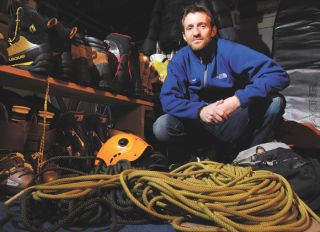Elite climber David Morton operates a climbing school for Sherpas in Nepal
By Breck Longstreth
Special to the Reporter
At the beginning of next week, David Morton will leave Seattle to climb Mt. Everest – again. He reached the summit for the first time in 2004, and has repeated the feat each year since.
As one of the world’s elite guides, Morton, 35, who grew up on Mercer Island, leads a peripatetic life. “When I first started, I would be gone for seven or eight months a year. This year, it will be the least, maybe four months,” said Morton, who has climbed and guided on seven continents, and scaled multiple 8,000-meter peaks. “It’s a very different lifestyle. A lot of people, when they get to my age, start to question it.”
And while Morton, who married in 2005, is just starting to wonder what direction his life might take in the future, he’s still very much in the present. He’s got a garage full of climbing equipment, he’s fit, and he’s looking forward to the challenges, both physical and mental, of his next expedition.
One thing Morton will do before leaving for Everest will be to give a talk and slide show at Evo, 122 N.W. 36th St. in the Fremont district of Seattle at 7 p.m. on Saturday, March 24. “For about half the time, I’ll tell stories about guiding and Mt. Everest, and for the other half, I’ll talk about the Khumbu Climbing School,” said Morton.
A project of the Alex Lowe Charitable Foundation, named after an alpinist who died in the Himalaya in 1999, the Khumbu Climbing School is an annual vocational training and instructional program for Nepali climbers. The program is designed to increase technical competency, and includes classes in wilderness medicine, leadership, outdoor rescue, and English. “When the Nepali climbers can communicate with the guides and climbers, it’s a huge advantage,” said Morton.
Morton is filled with admiration for the Sherpa, the Nepalese tribal group who inhabit the lower part of the Himalaya. Sherpa have been guides and climbers in the Himalaya since 1921, during the first Everest expedition. The most famous Sherpa, Tenzing Norgay, reached the summit of Everest with Edmund Hillary in 1953.
“The Sherpa are just unbelievably strong,” said Morton. “They have good lungs from living at that altitude, and they’ve grown up carrying big loads and walking everywhere.” But, he adds, “They’re not steeped in technical knowledge. Our goal is to make them safer.”
While the company Morton works for, Alpine Ascents International, is conscientious about training their Sherpa and other Nepalese employees, many operations aren’t. “Lots of the local companies just hire them, throw some crampons on them, and don’t give them any skills.” He adds, “If someone fell into a crevasse, 90 percent of them wouldn’t know how to do a rescue.”
This January, Morton and Pete Athans, a veteran of 15 Everest expeditions and one of Morton’s heroes when he was growing up, team-taught an advanced class at the Khumbu Climbing School.
Morton said instructors face some cultural challenges when training the Sherpa. “Very few can make the hard decisions that sometimes need to be made,” said Morton. “They have a very hard time saying, ‘No.’” This creates huge problems when a situation calls for turning clients around and telling them they can’t continue because it isn’t safe, and also for having to say ‘No’ to their immediate Sherpa bosses. It’s also difficult for the Nepalis, so strong themselves, to judge if someone (a Westerner) is physically strong enough to keep going. Add to that the fact that the Sherpa are fatalistic, and you can really have a problem, said Morton. “They’ll vocalize it, saying, ‘We can learn all this technical stuff, but if it’s our time to die, it’s time to die.’ You are certainly fighting that when training them.”
Early on, the Sherpa were horrified at the idea of climbing the Himalaya, which they considered the home of gods and goddesses. Even now, after more than 85 years, said Morton, “It’s considered a necessary evil. I don’t know any Sherpa who want their offspring to do that as a living; they know it’s dangerous.” Yet, by going on an Everest trip, they can make up to 10 times what an average Nepali family makes in a year, said Morton.
All of the Sherpa with whom Morton works are trained by a sirdar (Sherpa captain), Lakpa Rita Sherpa, who lives with his family in Seattle, but is off on expeditions nine months a year. “He has trained all of our Sherpa really well,” said Morton.
So, confident in his Sherpa companions, and looking forward to a three-week visit at base camp from his wife Kristine, Morton is eagerly anticipating his trip. But he’s not sure he’ll be doing the same thing ten years from now. “The Everest thing - there’s something about it that’s too intense to make a habit of it,” he said.
Event
David Morton presents: Ten Seasons In The Khumbu: Images and Stories from Guiding, Climbing, and Adventuring in the Himalaya at 7 p.m. on Saturday, March 24 at Evo, 122 N.W. 36th St., in the Fremont neighborhood of Seattle.
Morton’s presentation is a benefit for the Alex Lowe Charitable Foundation and its Khumbu Climbing School. The school’s mission is to increase the safety margin of Nepali climbers and high altitude workers by encouraging responsible climbing practices in a supportive, community-based program.


